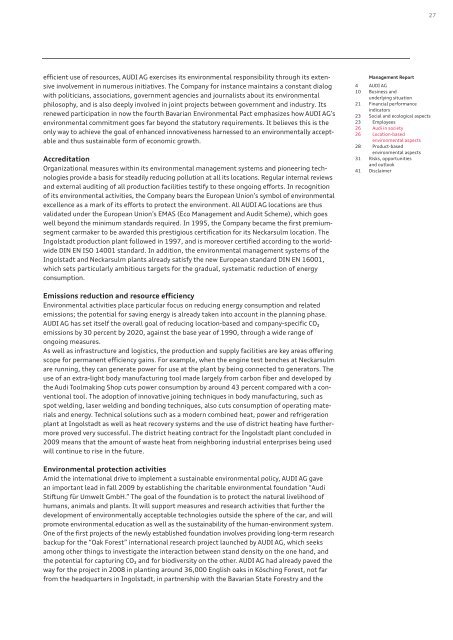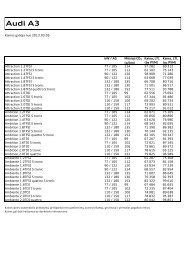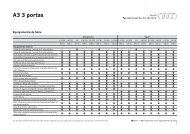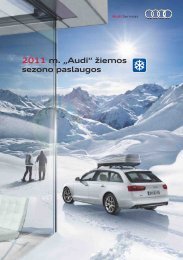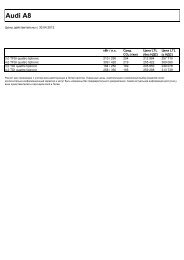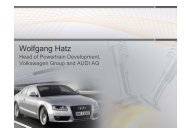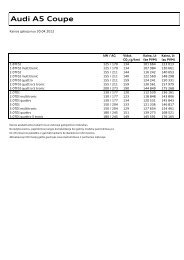Annual Financial Statements Of AUDI AG
Annual Financial Statements Of AUDI AG
Annual Financial Statements Of AUDI AG
Create successful ePaper yourself
Turn your PDF publications into a flip-book with our unique Google optimized e-Paper software.
efficient use of resources, <strong>AUDI</strong> <strong>AG</strong> exercises its environmental responsibility through its extensive<br />
involvement in numerous initiatives. The Company for instance maintains a constant dialog<br />
with politicians, associations, government agencies and journalists about its environmental<br />
philosophy, and is also deeply involved in joint projects between government and industry. Its<br />
renewed participation in now the fourth Bavarian Environmental Pact emphasizes how <strong>AUDI</strong> <strong>AG</strong>’s<br />
environmental commitment goes far beyond the statutory requirements. It believes this is the<br />
only way to achieve the goal of enhanced innovativeness harnessed to an environmentally acceptable<br />
and thus sustainable form of economic growth.<br />
Accreditation<br />
Organizational measures within its environmental management systems and pioneering technologies<br />
provide a basis for steadily reducing pollution at all its locations. Regular internal reviews<br />
and external auditing of all production facilities testify to these ongoing efforts. In recognition<br />
of its environmental activities, the Company bears the European Union’s symbol of environmental<br />
excellence as a mark of its efforts to protect the environment. All <strong>AUDI</strong> <strong>AG</strong> locations are thus<br />
validated under the European Union’s EMAS (Eco Management and Audit Scheme), which goes<br />
well beyond the minimum standards required. In 1995, the Company became the first premiumsegment<br />
carmaker to be awarded this prestigious certification for its Neckarsulm location. The<br />
Ingolstadt production plant followed in 1997, and is moreover certified according to the worldwide<br />
DIN EN ISO 14001 standard. In addition, the environmental management systems of the<br />
Ingolstadt and Neckarsulm plants already satisfy the new European standard DIN EN 16001,<br />
which sets particularly ambitious targets for the gradual, systematic reduction of energy<br />
consumption.<br />
Emissions reduction and resource efficiency<br />
Environmental activities place particular focus on reducing energy consumption and related<br />
emissions; the potential for saving energy is already taken into account in the planning phase.<br />
<strong>AUDI</strong> <strong>AG</strong> has set itself the overall goal of reducing location-based and company-specific CO₂<br />
emissions by 30 percent by 2020, against the base year of 1990, through a wide range of<br />
ongoing measures.<br />
As well as infrastructure and logistics, the production and supply facilities are key areas offering<br />
scope for permanent efficiency gains. For example, when the engine test benches at Neckarsulm<br />
are running, they can generate power for use at the plant by being connected to generators. The<br />
use of an extra-light body manufacturing tool made largely from carbon fiber and developed by<br />
the Audi Toolmaking Shop cuts power consumption by around 43 percent compared with a conventional<br />
tool. The adoption of innovative joining techniques in body manufacturing, such as<br />
spot welding, laser welding and bonding techniques, also cuts consumption of operating materials<br />
and energy. Technical solutions such as a modern combined heat, power and refrigeration<br />
plant at Ingolstadt as well as heat recovery systems and the use of district heating have furthermore<br />
proved very successful. The district heating contract for the Ingolstadt plant concluded in<br />
2009 means that the amount of waste heat from neighboring industrial enterprises being used<br />
will continue to rise in the future.<br />
Environmental protection activities<br />
Amid the international drive to implement a sustainable environmental policy, <strong>AUDI</strong> <strong>AG</strong> gave<br />
an important lead in fall 2009 by establishing the charitable environmental foundation “Audi<br />
Stiftung für Umwelt GmbH.” The goal of the foundation is to protect the natural livelihood of<br />
humans, animals and plants. It will support measures and research activities that further the<br />
development of environmentally acceptable technologies outside the sphere of the car, and will<br />
promote environmental education as well as the sustainability of the human-environment system.<br />
One of the first projects of the newly established foundation involves providing long-term research<br />
backup for the “Oak Forest” international research project launched by <strong>AUDI</strong> <strong>AG</strong>, which seeks<br />
among other things to investigate the interaction between stand density on the one hand, and<br />
the potential for capturing CO₂ and for biodiversity on the other. <strong>AUDI</strong> <strong>AG</strong> had already paved the<br />
way for the project in 2008 in planting around 36,000 English oaks in Kösching Forest, not far<br />
from the headquarters in Ingolstadt, in partnership with the Bavarian State Forestry and the<br />
27<br />
Management Report<br />
4 <strong>AUDI</strong> <strong>AG</strong><br />
10 Business and<br />
underlying situation<br />
21 <strong>Financial</strong> performance<br />
indicators<br />
23 Social and ecological aspects<br />
23 Employees<br />
26 Audi in society<br />
26 Location-based<br />
environmental aspects<br />
28 Product-based<br />
environmental aspects<br />
31 Risks, opportunities<br />
and outlook<br />
41 Disclaimer


